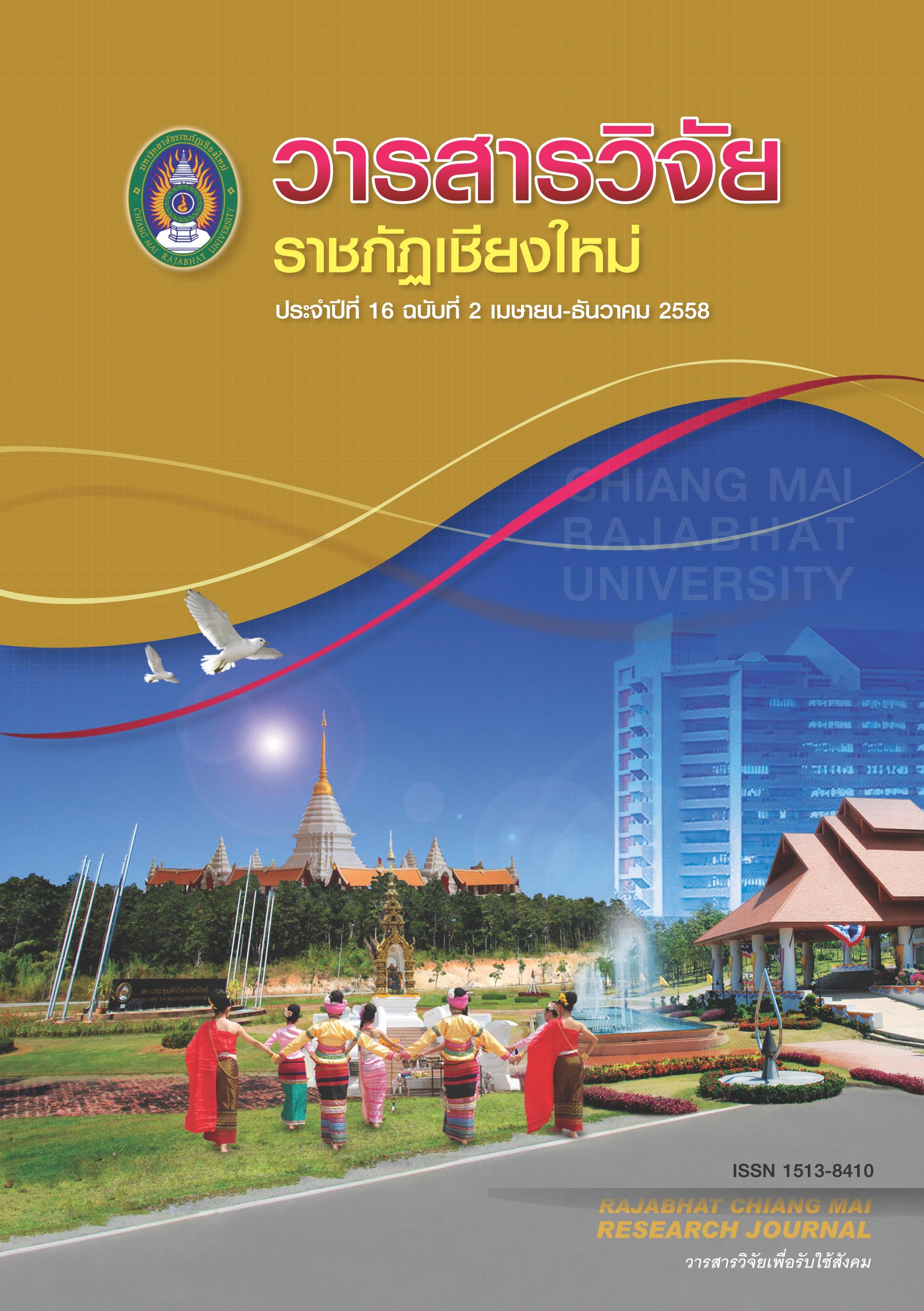การพัฒนาครูในการสร้างฐานข้อมูลแหล่งเรียนรู้และภูมิปัญญาท้องถิ่นเพื่อยกระดับคุณภาพการเรียนการสอน
DOI:
https://doi.org/10.14456/rcmrj.2015.215075คำสำคัญ:
การพัฒนาครู, ฐานข้อมูล, แหล่งเรียนรู้และภูมิปัญญาท้องถิ่นบทคัดย่อ
การวิจัยในครั้งนี้ มีวัตถุประสงค์เพื่อ 1) พัฒนาครูในการสร้างฐานข้อมูลแหล่งเรียนรู้และภูมิปัญญาท้องถิ่น และ 2) ศึกษาผลพัฒนาครูในการสร้างฐานข้อมูลแหล่งเรียนรู้และภูมิปัญญาท้องถิ่นเพื่อยกระดับคุณภาพการเรียนการสอนโดยใช้การวิจัยปฏิบัติการ (action research) 4 ขั้นตอน ได้แก่ การวางแผน (planning) การปฏิบัติ (action) การสังเกต (observation) และการสะท้อนผล (reflection) กลุ่มเป้าหมาย คือ ครูโรงเรียนชลประทานผาแตก จำนวน 29 คน ผู้ให้ข้อมูลคือ นักเรียน จำนวน 20 คน ผู้ปกครองนักเรียน จำนวน 15 คน และภูมิปัญญาท้องถิ่น จำนวน 15 คน เครื่องมือที่ใช้ในการวิจัยคือ แบบวิเคราะห์เอกสาร แนวทางการระดมสมอง แบบสังเกตพฤติกรรมของครู แบบสัมภาษณ์ครู แบบสัมภาษณ์นักเรียน แบบทดสอบก่อน – หลังการประชุมเชิงปฏิบัติการ และแบบสอบถามความพึงพอใจของครู การหาคุณภาพของเครื่องมือใช้วิธีการหาค่าดัชนีความสอดคล้องระหว่างเนื้อหากับจุดประสงค์ (Index of Item – Objective Congruence หรือ IOC) จากผู้เชี่ยวชาญและการหาค่าความเชื่อมั่นของแบบทดสอบและแบบสอบถามโดยใช้ค่าสัมประสิทธิ์แอลฟา (α-coefficient) ของครอนบัค วิเคราะห์ข้อมูลเชิงปริมาณโดยใช้ค่าร้อยละ ค่าเฉลี่ย ค่าเบี่ยงเบนมาตรฐาน และข้อมูลเชิงคุณภาพใช้การวิเคราะห์เชิงเนื้อหา แล้วนำเสนอผลวิจัยโดยใช้วิธีการพรรณนา ผลการวิจัยสรุปได้ดังนี้
1. การพัฒนาครูในการสร้างฐานข้อมูลแหล่งเรียนรู้และภูมิปัญญาท้องถิ่นโดยมีการดำเนินงาน 13 กิจกรรม ดังนี้ 1) วิเคราะห์เอกสารและการระดมสมองเพื่อศึกษาประเด็นปัญหาและความต้องการในการพัฒนาครูโดยใช้แหล่งเรียนรู้และภูมิปัญญาท้องถิ่น 2) วางแผนการพัฒนาครู 3) ประชุมเชิงปฏิบัติการวิเคราะห์แหล่งเรียนรู้และภูมิปัญญาท้องถิ่น 4) ประชุมเชิงปฏิบัติการวิเคราะห์หลักสูตรเพื่อใช้แหล่งเรียนรู้และภูมิปัญญาท้องถิ่น 5) ประชุมเชิงปฏิบัติการจัดทำฐานข้อมูลแหล่งเรียนรู้และภูมิปัญญาท้องถิ่น 6) หาคุณภาพฐานข้อมูลแหล่งเรียนรู้และภูมิปัญญาท้องถิ่น 7) ประชุมเชิงปฏิบัติการออกแบบหน่วยการเรียนรู้ 8) ประชุมเชิงปฏิบัติการจัดทำแผนการจัดการเรียนรู้ 9) นิเทศติดตามการออกแบบหน่วยการเรียนรู้และการจัดทำแผนการจัดการเรียนรู้ 10) หาคุณภาพของหน่วยการเรียนรู้และแผนการจัดการเรียนรู้ 11) ครูจัดกิจกรรมการเรียนรู้ให้แก่นักเรียน 12) สังเกตพฤติกรรมของครูและนิเทศเป็นระยะเพื่อสอบถามปัญหา ช่วยเหลือ และแก้ไข ปัญญาที่เกิดขึ้นในแง่มุมต่างๆ ตลอดการจัดกิจกรรมการเรียนรู้ 13) จัดประชุมเชิงปฏิบัติการเพื่อสะท้อนผลการจัดการเรียนรู้ให้ผู้บริหารโรงเรียน คณะครูได้รับทราบ
2. ผลการพัฒนาครูในการสร้างฐานข้อมูลแหล่งเรียนรู้และภูมิปัญญาท้องถิ่น พบว่า ครู ทุกคนมีความรู้ ความเข้าใจในการสร้างฐานข้อมูลแหล่งเรียนรู้และภูมิปัญญาท้องถิ่นโดยมีคะแนนรวมเฉลี่ยหลังประชุมเชิงปฏิบัติการสูงกว่าก่อนการประชุมเชิงปฏิบัติการคิดเป็นร้อยละ93 และ มีความพึงพอใจต่อการจัดการเรียนรู้โดยใช้ฐานข้อมูลแหล่งเรียนรู้และภูมิปัญญาท้องถิ่น ด้านกิจกรรมพัฒนาครูมากที่สุดมีค่าเฉลี่ยเท่ากับ 4.56 รองลงมา คือ ด้านการใช้ฐานข้อมูล ด้านการจัด การเรียนรู้ และด้านการบริหารจัดการ มีค่าเฉลี่ยเท่ากับ 4.54, 4.52, 4.51 ตามลำดับ
3. ผลการจัดการเรียนรู้โดยใช้ฐานข้อมูลแหล่งเรียนรู้และภูมิปัญญาท้องถิ่นพบว่า นักเรียนมีร้อยละคะแนนความก้าวหน้าของผลสัมฤทธิ์ทางการเรียนสูงขึ้นทุกชั้นเรียนคืออยู่ระหว่าง 56 - 40.03 สำหรับความคิดเห็นของนักเรียน พบว่า นักเรียนมีความสุข สนุกสนานที่ได้เรียนรู้จากประสบการณ์จริงจนเกิดความรู้ความเข้าใจ ความภาคภูมิใจและเห็นคุณค่าในวัฒนธรรม ประเพณี แหล่งเรียนรู้และภูมิปัญญาท้องถิ่นในชุมชน
Downloads
เอกสารอ้างอิง
ธีรพงศ์ เสนาวงศ์. 2553. การพัฒนาบุคลากรในการจัดการเรียนรู้โดยอาศัยภูมิปัญญาท้องถิ่นและแหล่งการเรียนรู้ท้องถิ่น โรงเรียนช้างเผือกวิทยาคม อำเภอสุวรรณภูมิ จังหวัดร้อยเอ็ด. การศึกษาค้นคว้าอิสระ ศึกษาศาสตรมหาบัณฑิต บัณฑิตวิทยาลัย มหาวิทยาลัยมหาสารคาม.
นงลักษณ์ เลื่อมใส. 2556. การพัฒนาครูด้านการจัดกิจกรรมการเรียนการสอนบูรณาการแหล่งเรียนรู้ในชุมชน กลุ่มสาระการเรียนรู้วิทยาศาสตร์โรงเรียนเสลภูมิ อำเภอเสลภูมิ จังหวัดร้อยเอ็ด. การศึกษาค้นคว้าอิสระศึกษาศาสตรมหาบัณฑิต บัณฑิตวิทยาลัย มหาวิทยาลัยมหาสารคาม.
เบญจพร สายแวว. 2555. การพัฒนาระบบฐานข้อมูลแหล่งเรียนรู้ภูมิปัญญาท้องถิ่นและสื่อการเรียนรู้ สำนักงานเขตพื้นที่การศึกษาประถมศึกษาอุบลราชธานี เขต 2. วิทยานิพนธ์ วิทยาศาสตรมหาบัณฑิต บัณฑิตวิทยาลัย มหาวิทยาลัยราชภัฏอุบลราชธานี.
พัชราภรณ์ ชัยพัฒนเมธี. 2556. การพัฒนาฐานข้อมูลภูมิปัญญาท้องถิ่น เรื่อง การทอผ้าของกลุ่มสตรีทอผ้าหมู่บ้านเขาเต่า อำเภอหัวหินจังหวัดประจวบคีรีขันธ์. กรุงเทพฯ: มหาวิทยาลัยเทคโนโลยีราชมงคลรัตนโกสินทร์.
มาลัย ภักดีเกียรติ. 2554. ผลการใช้ชุดการเรียนโดยใช้แหล่งเรียนรู้ในชุมชนและธรรมชาติเรื่องการดำรงพันธุ์ของพืช สำหรับนักเรียนชั้นประถมศึกษาปีที่ 5. วิทยานิพนธ์ วิทยาศาสตรมหาบัณฑิต บัณฑิตวิทยาลัย มหาวิทยาลัยราชภัฏบุรีรัมย์.
ยุพิน อินทะยะ. 2550. แหล่งการเรียนรู้และภูมิปัญญาท้องถิ่นเพื่อการเรียนการสอน. เชียงใหม่: สาขาวิชาหลักสูตรและการสอน คณะครุศาสตร์ มหาวิทยาลัยราชภัฏเชียงใหม่.
โรงเรียนชลประทานผาแตก. 2556. รายงานการประเมินตนเองปีการศึกษา 2556. เชียงใหม่: ม.ป.ท.
สำนักงานคณะกรรมการการศึกษาแห่งชาติ. 2545. ตัวบ่งชี้การเรียนการสอนที่เน้นผู้เรียนเป็นสำคัญที่สุด. กรุงเทพฯ: 21 เซ็นจูรี่.
สุพิน นาสมบูรณ์. 2553. การพัฒนาการมีส่วนร่วมของชุมชนในการนำภูมิปัญญาท้องถิ่นมาใช้ในการจัดกิจกรรมการเรียนรู้แก่นักเรียนโรงเรียนฟ้าแดดสูงยางวิทยาคาร อำเภอกมลาไสย จังหวัดกาฬสินธุ์. การศึกษาค้นคว้าอิสระ ศึกษาศาสตรมหาบัณฑิต บัณฑิตวิทยาลัย มหาวิทยาลัยมหาสารคาม.
อุมาพร สวัสดิ์ศรี. 2557. ผลการจัดกิจกรรมการเรียนรู้ เรื่อง การย้อมสีผ้าฝ้ายด้วยสีธรรมชาติ โดยใช้แหล่งเรียนรู้ในชุมชน กลุ่มสาระการเรียนรู้การงานอาชีพและเทคโนโลยีชั้นประถมศึกษาปีที่ 6. วิทยานิพนธ์ ศึกษาศาสตรมหาบัณฑิต บัณฑิตวิทยาลัย มหาวิทยาลัยขอนแก่น.
ดาวน์โหลด
เผยแพร่แล้ว
รูปแบบการอ้างอิง
ฉบับ
ประเภทบทความ
สัญญาอนุญาต
1. บทความ ข้อมูล เนื้อหา รูปภาพ ฯลฯ ที่ได้รับการตีพิมพ์ใน “Community and Social Development Journal” ถือเป็นลิขสิทธิ์ของ Community and Social Development Journal มหาวิทยาลัยราชภัฏเชียงใหม่ และเพื่อให้เผยแพร่บทความได้อย่างเหมาะสมผ่านสื่อสิ่งพิมพ์และอิเล็กทรอนิกส์ ผู้เขียนยังคงถือครองลิขสิทธิ์บทความที่ตีพิมพ์ภายใต้ใบอนุญาต Creative Commons Attribution (CC BY) ซึ่งอนุญาตให้เผยแพร่บทความซ้ำในแหล่งอื่นได้ โดยอ้างอิงต้องอ้งอิงบทความในวารสาร ผู้เขียนต้องรับผิดชอบในการขออนุญาตผลิตซ้ำเนื้อหาที่มีลิขสิทธิ์จากแหล่งอื่น
2. เนื้อหาบทความที่ปรากฏในวารสารเป็นความรับผิดชอบของผู้เขียนบทความโดยตรง ซึ่งกองบรรณาธิการวารสารไม่จำเป็นต้องเห็นด้วยหรือร่วมรับผิดชอบใดๆ














